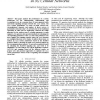1900 search results - page 247 / 380 » The Four Phase Method for Modelling Complex Systems |
BMCBI
2008
14 years 10 months ago
2008
Background: Probability based statistical learning methods such as mutual information and Bayesian networks have emerged as a major category of tools for reverse engineering mecha...
ICC
2007
IEEE
15 years 4 months ago
2007
IEEE
— This paper analyzes the performance of a system architecture for the Authentication, Authorization, and Accounting (AAA), in a scenario where 3G users generate traffic and invo...
ICRA
2007
IEEE
15 years 4 months ago
2007
IEEE
— The rapidly increasing complexity of tasks robotic systems are expected to carry out underscores the need for the development of motion planners that can take into account disc...
APSEC
1999
IEEE
15 years 2 months ago
1999
IEEE
The management of complexity in large systems is traditionally focused on the modeling and management of classes and hierarchies of classes. In order to improve the compositional ...
DATE
2008
IEEE
15 years 4 months ago
2008
IEEE
Failure Mode and Effects Analysis (FMEA) is a wellknown technique widely used for safety assessment in the area of safety-critical systems. However, FMEA is traditionally done man...

